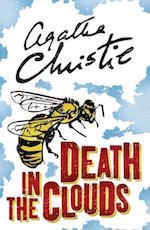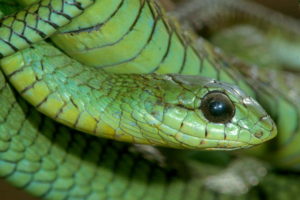
Poirot Score: 68
Death in the Clouds
☆☆☆
Reasons for Poirot Score
This is an enjoyable read but the clueing and plot are not such to lead the reader to a single irrefutable solution. I thought of at least two other possible solutions that fitted the available clues just as well.
Click here for full Review (spoilers ahead)
Trivia
Book dedication to Ormond Beadle
The only reference to Ormond Beadle on the internet is a publication by Ormond A. Beadle: Intervertebral discs in 1931. I cannot find any mention of a friendship between Beadle and Christie in her biographies. Perhaps he treated her, or explained the anatomy of the neck for Lord Edgware Dies?
Digs at archeologists
Agatha Christie’s happy second marriage was to the young archeologist, Max Mallowan. One of the pleasures of reading this book are the sly comments about archaeologists throughout. On their honeymoon in September 1930, Christie had terrible food poisoning in Athens. Max Mallowan had to be in Baghdad by October 15th, for his job, and left her. Christie had to go back alone on the train to London two days later. The Greek doctor who attended her was shocked. Christie wreaks her revenge in this novel, when the archaeologist Dupont says of an Englishman who left his wife: ‘
they thought him noble, unselfish. But the doctor, who was not English, thought him a barbarian’.
’You are not, perhaps, acquainted with many archaeologists?… their concentration would be such that they would be quite blind and deaf to the outside world. They would be existing, you see, in five thousand or so BC.’
Japp says
‘an archaeologist is a poor kind of fish. Always burrowing in the ground and talking through his hat about what happened thousands of years ago – and how do they know, I should like to know?’
Christie is always fair. She allows M. Dupont to wax lyrical about his profession: ‘It is amazing how little the average person cares for pottery. Pottery – the whole romance of humanity can be expressed in terms of pottery’. Perhaps Christie felt she ought to say something positive.
Boomslang snake venom
The South African tree snakes, Dispholidus typus or boomslangs, are shy creatures. “Boomslang” means tree snake in Afrikaans, but there are many other species of tree snakes in South Africa, including the dangerously venomous “bird, twig, vine, or tree snakes” Genus Thelotornis. There are occasional reports of bites and fatalities. Snakebite cases in Africa are generally under-reported, especially those attributable to a particular species: usually the snake rushes off, without waiting to be identified and killed. Boomslangs have a very wide distribution throughout the whole savanna region of Africa, so it is likely that there are hundreds of humans bitten each year.
For a person bitten, who arrives at a hospital in the 21st century, there is a 24-48 hour window in which a patient may be sustained with general supportive measures, whilst the specific anti-venom is ordered and delivered. It simply is not economical to have every South African hospital stocked with anti-venom, when it is required so infrequently. The authors in this recent paper [African Journal of Emergency Medicine (2019 Mar; 9(1): 53–55. Fatal Boomslang bite in the Northern Cape written by H J Krügera and F G Lemkea] describe a case report of a young man who died about eight hours after being bitten twice, and argue he may have died quickly because double the amount of venom was probably injected, and juvenile boomslangs may have more potent venom.
In Death in the Clouds the chief government analyst says ‘injecting the venom into a hyena, the hyena died before the needle could be withdrawn’. He also states that the poison’s effect ‘on a human being is not known’. Christie went to South Africa, on a round the world trip with her first husband in 1922, so she might well have heard stories about fatal boomslang bites.
The first report that bites by the boomslang were potentially very dangerous was by FW FitzSimons in 1909. FitzSimons described the near-fatal envenoming in one of his staff in 1907 and a fatality in South Africa. He then did some experiments in animals. Bites killed chickens and ducks very rapidly (quickest in 3 minutes) and “The glands of a variegated boomslang were rubbed up with a little water injected with a hypodermic syringe into a vein in a live and active Cape Jackal. The animal died before the needle could be withdrawn. It perished as quickly as if shot through the head with a bullet. The venom, being injected into a vein, reached the heart almost immediately, and instantly paralysed its action”. This was obviously the basis for Agatha Christie’s text.
With the benefit of much more recent medical research, it is clear that Madame Giselle would have been perfectly oblivious of the poison, although she may have thought a wasp had stung her in the neck. She would have walked off the plane along with the other passengers. It is not clear how much dried poison could be injected by an envenomed thorn, even directly into the jugular vein, but possibly enough to cause Madame Giselle serious haemorrhagic abnormalities, one to two days later. This would actually have been the perfect crime, as no one would have associated Madame Giselle’s then serious haemorrhaging with a plane flight two days previously. Poirot would never have been involved.
Specific boomslang antivenom was developed by the South African Institute but not until later in the 1930s, after this book was written.
[I would like to thank the generosity of Professor David Warrel, Emeritus Professor of Tropical Medicine, Nuffield Department of Clinical Medicine; Honorary Consultant Physician, Oxford University Hospitals Trust; Honorary Fellow, St Cross College, for reading, and advising on this section. All inaccuracies are my own, all edification is from Professor Warrel. Professor Warrel is currently a core-member of the WHO working group on snake-bite envenoming. Prof Warrel has co-authored the Oxford Handbook of Expedition and Wilderness Medicine, and hundreds of other textbooks and papers. ]
Blow Pipes:
Christie came in for criticism, when this book was first published, about the short length of the blow pipe, being about a foot long rather than six feet. In Mrs McGinty’s Dead 1951, Christie’s alter-ego, the female detective fiction writer, Ariadne Oliver, mentions the complaints about the size of the blow pipe, and says ‘Sometimes I think there are people who only read books in the hope of finding mistakes in them’. This criticism clearly hurt Christie, as she refers to it sixteen years later. Given that the blowpipe was never actually used in the murder, but bought to be a ‘plant’ only, its length seems immaterial. Christie might even have argued it was a rather brilliant clue.
Fictional detective fiction writers
Mr Clancy was Christie’s first fictional detective fiction writer in one of her full-length novels. One can see Clancy as the prototype for Ariadne Oliver, who Christie chose to develop. Ariadne Oliver had already appeared in a short story from 1932, Parker Pyne, but with hardly any description other than she is ‘the sensational novelist’, who eats apples, and makes up scenarios for Parker Pyne’s clientele. In 1936, Christie introduces Oliver for the first time in a novel in Cards on The Table, published the year after Death in The Clouds. Christie enjoyed using the character of a detective fiction writer to add humour. A number of Clancy’s books are mentioned in Clouds: The Clue of the Scarlet Petal and Murder on Vesuvius. Clancy also rewrites his first hand experiences from Death in The Clouds as fiction under the title The Air Mail Mystery. Why Christie settled on Ariadne Oliver for further development, rather than the engaging Mr Clancy, is not clear.
Japp has no time for Clancy ‘These detective story writers …always making the police out to be fools…and getting their procedure all wrong. Why, if I were to say the things to my super that their inspectors say to superintendents I should be thrown out of the Force tomorrow on my ear. Set of ignorant scribblers!’
Croydon and Le Bourget aerodromes
Croydon aerodrome was Britain’s only international airport, opened in 1920, when Death in the Clouds was written. In the Second World War, Heathrow aerodrome was developed to take the evolving larger aeroplanes, and Croydon closed completely in 1959. Le Bourget was the only aerodrome in Paris, until Orly was built in 1932, but unlike Croydon still hosts business jets and the Paris Air Show.
Flapjacks?
In Chapter 8, there are lists of the extraneous objects from the pockets and hand luggage of all the first class occupants. A 1930s powder ‘flapjack’
A 1930s powder ‘flapjack’
Miss Kerr, Miss Grey and Lady Horbury each have a ‘flapjack’ in their respective bags.
I thought it odd they each had an oaty snack in their bags.
According to the OED:
The 1600 definition of a flapjack is ‘a flat cake, a pancake’.
It only became an oaty biscuit with syrup in 1935, two years after this book was published.
In 1934 it was used in Punch as ‘a vanity case for face-powder’: a flat cake of powder.
Clearly if the contributors to OED had read Agatha Christie, they might have quoted Death in The Clouds.


